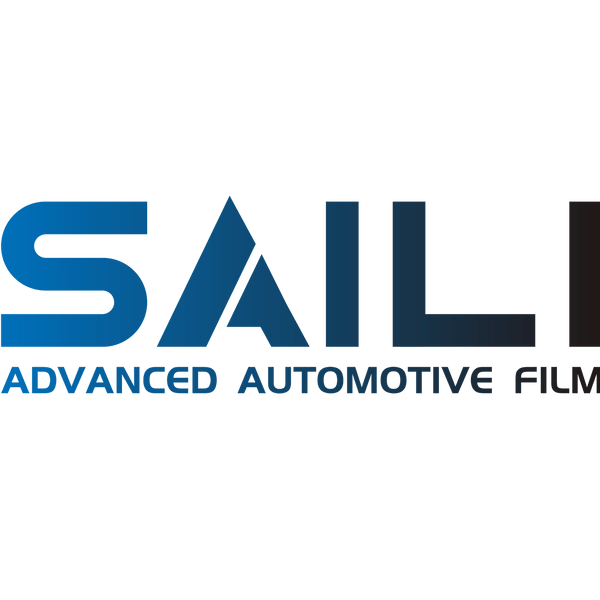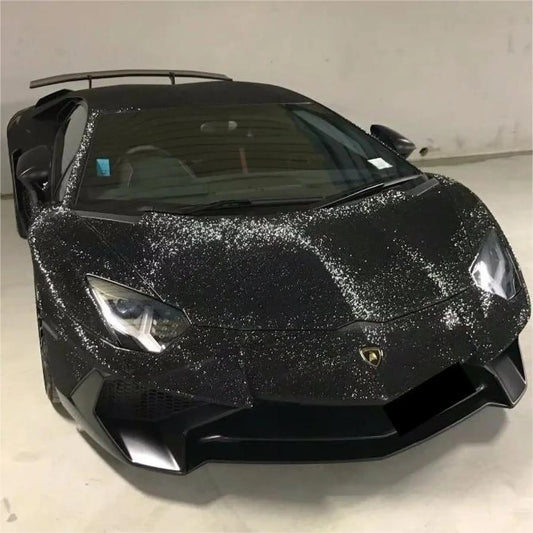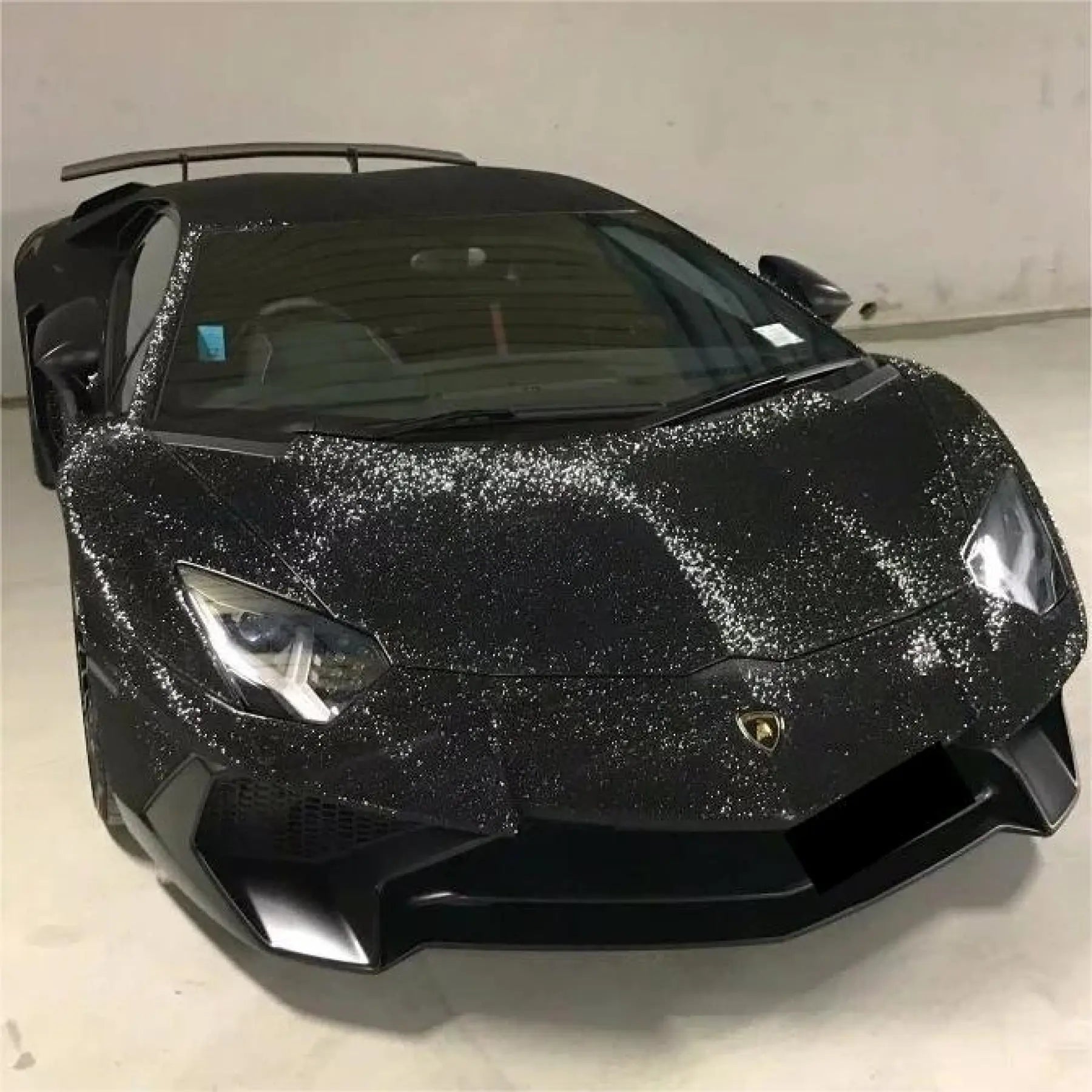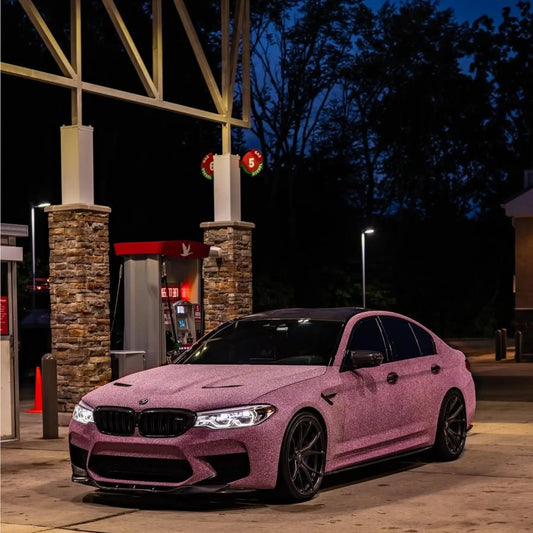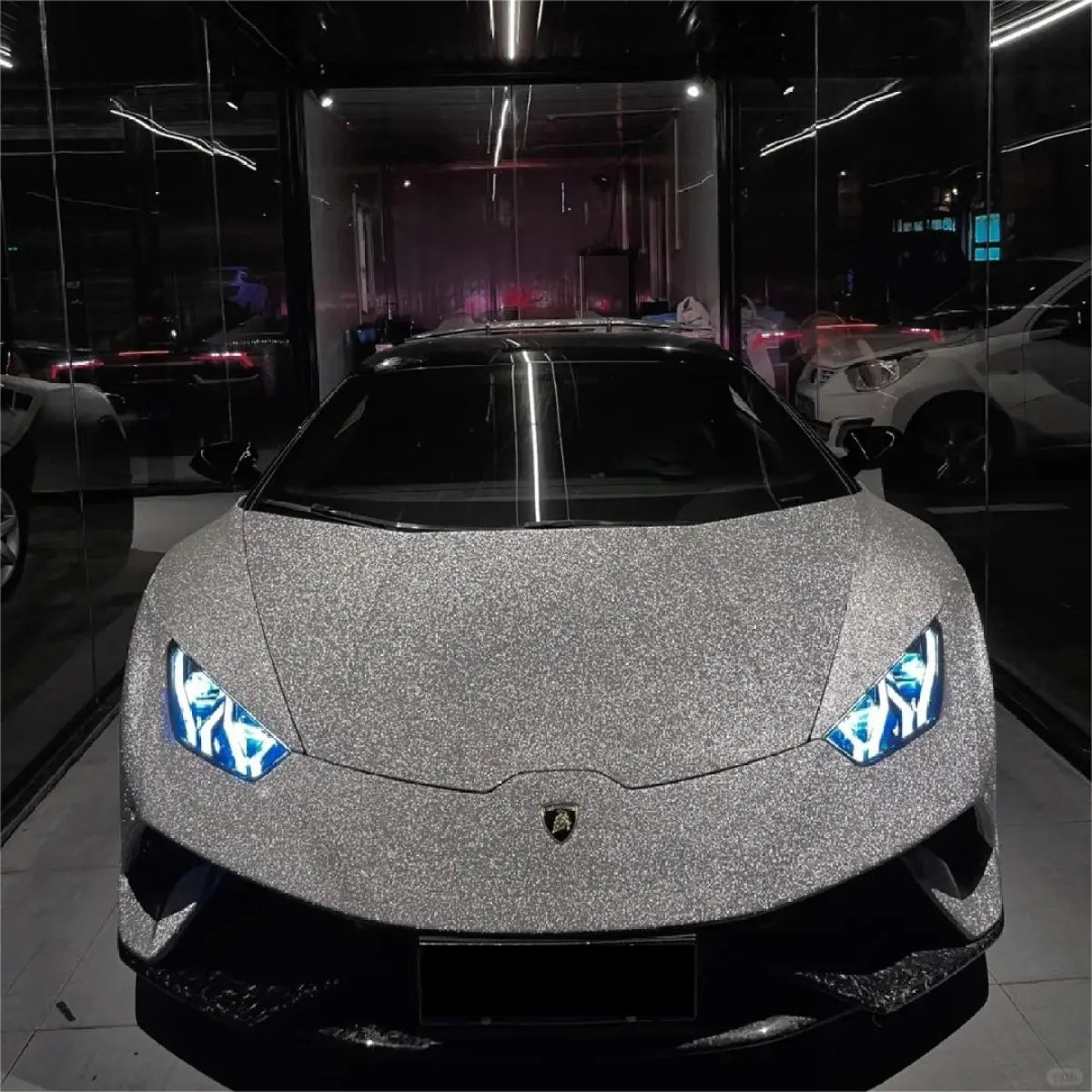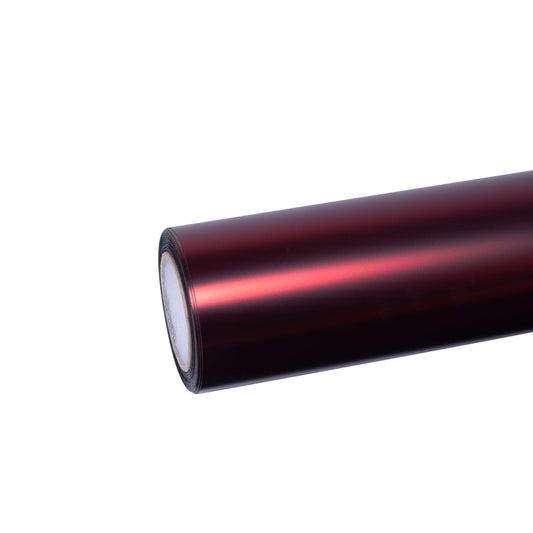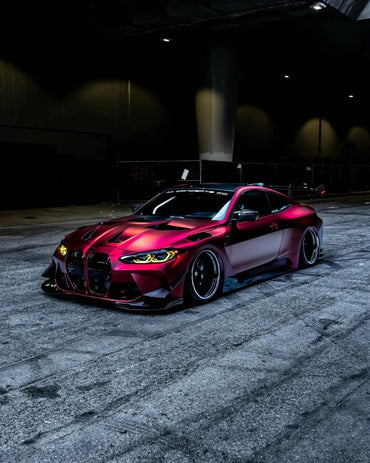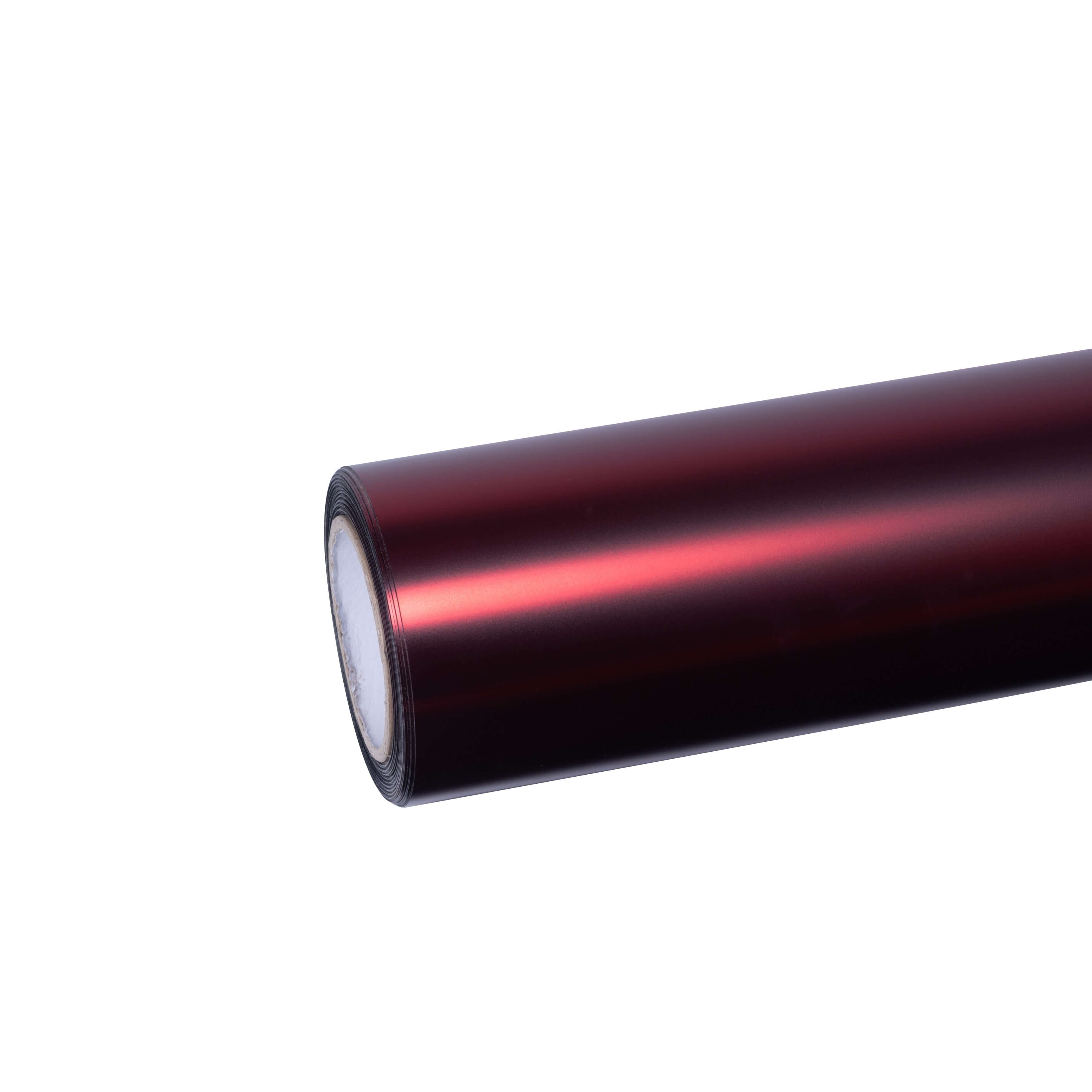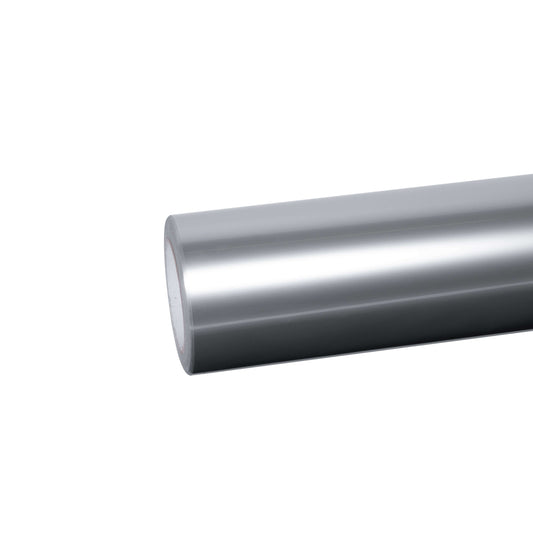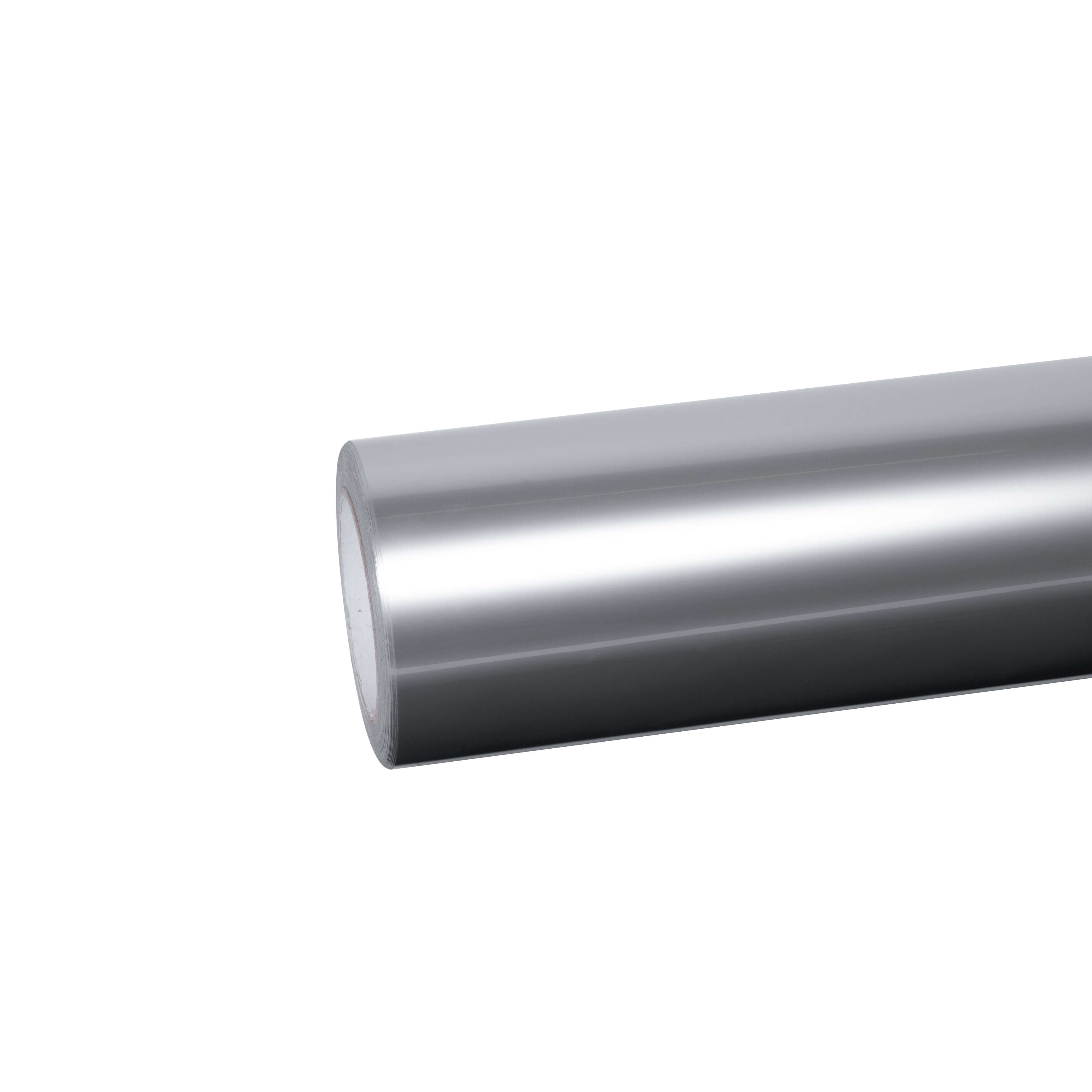What Are Hydrophobic Topcoats and Why Do They Matter?
Hydrophobic topcoats represent advanced nano-ceramic technology applied to the surface layer of premium automotive films. The term "hydrophobic" derives from Greek, meaning "water-fearing," which perfectly describes how these coatings interact with moisture. Modern paint protection films with hydrophobic properties create microscopic surface structures that repel water molecules through high contact angles—typically exceeding 110 degrees.
When water encounters a hydrophobic surface, instead of spreading into a thin film that promotes contamination and water spots, it forms tight beads that roll off effortlessly. This fundamental behavior determines how effectively your wrap protects against environmental hazards ranging from acid rain to road salt contamination.
The Science Behind Water Contact Angles
Surface protection effectiveness correlates directly with contact angle measurements. Standard wax products achieve approximately 80-90 degree contact angles, providing minimal protection. Traditional vinyl wraps without hydrophobic enhancement typically measure 70-85 degrees. In contrast, Sailifilm's premium TPU paint protection wrap collection features advanced hydrophobic topcoats achieving contact angles between 110-120 degrees, delivering superior water repellency that actively protects your investment.
The physics behind this phenomenon centers on surface tension and molecular attraction. Water molecules naturally bond together through cohesive forces. When these molecules encounter a hydrophobic surface with minimal adhesive attraction, they minimize surface contact by forming spherical droplets—the tightest possible configuration for liquid molecules.
How Hydrophobic Technology Protects Car Wraps
Protection mechanisms extend far beyond aesthetic water beading effects. Hydrophobic topcoats deliver multiple layers of defense for wrapped vehicles:
Contaminant Prevention Through Active Repulsion
Environmental contaminants pose constant threats to automotive finishes. Bird droppings contain uric acid with pH levels as low as 3.5, capable of etching unprotected surfaces within hours. Industrial fallout deposits microscopic metal particles that oxidize and bond to porous surfaces. Tree sap creates sticky residues that attract dirt while its natural acids slowly degrade vinyl materials.
Hydrophobic topcoats create a molecular barrier that prevents these contaminants from bonding directly to wrap surfaces. When water beads form and roll away, they carry contaminants with them before adhesion occurs. This self-cleaning effect dramatically reduces the frequency of deep cleaning sessions required to maintain wrap appearance.
Our colored paint protection film range incorporates military-grade hydrophobic technology originally developed for aerospace applications, ensuring maximum contamination resistance across diverse environmental conditions.
UV Protection and Oxidation Resistance
Ultraviolet radiation represents one of the most damaging environmental factors for automotive surfaces. UV rays break down molecular bonds in both vinyl and paint, causing fading, chalking, and eventual material failure. Standard vinyl wraps without UV protection show visible degradation within 18-24 months of continuous exposure.
Premium hydrophobic topcoats contain UV-stabilizing compounds that absorb harmful radiation before it penetrates the film structure. These nano-ceramic particles act as molecular sunscreen, reflecting UV wavelengths while allowing visible light to pass through. This technology explains why Sailifilm's TPU wraps maintain color vibrancy and optical clarity for 7-10 years compared to 3-5 years for standard vinyl alternatives.
Preventing Water Spot Etching
Hard water contains dissolved minerals—primarily calcium and magnesium carbonates—that remain on surfaces after evaporation. These mineral deposits create permanent etching on porous materials, appearing as white spots that cannot be removed without aggressive polishing.
Hydrophobic surfaces minimize water spot formation through two mechanisms. First, reduced contact area means less water remains on the surface to evaporate. Second, when water does evaporate, mineral deposits sit atop the hydrophobic layer rather than etching into the material itself. Simple rinsing removes these loose deposits before permanent damage occurs.
This protection proves particularly valuable for vehicles experiencing frequent rain exposure or automatic car wash cycles. Sailifilm's hydrophobic technology ensures your wrap maintains pristine appearance regardless of environmental exposure patterns.
Self-Healing Technology Integration with Hydrophobic Coatings
Modern paint protection represents the convergence of multiple advanced technologies. Self-healing capability combines with hydrophobic properties to create unprecedented protective performance. When minor scratches occur on self-healing paint protection film, the TPU's molecular structure responds to heat by flowing back into place, effectively erasing the damage.
How Self-Healing Complements Hydrophobic Protection
Thermoplastic polyurethane exhibits unique viscoelastic properties that allow molecular reorganization when heated. Sunlight warming the film surface or exposure to hot water triggers this self-healing response. Scratches ranging from light swirls to moderate abrasions measuring up to 1-2 millimeters deep can completely disappear within 24-72 hours.
The hydrophobic topcoat works synergistically with this self-healing base layer. While the TPU substrate repairs structural damage, the hydrophobic coating maintains surface protection throughout the healing process. This dual-action technology explains why premium colored PPF options deliver protection levels impossible with traditional materials.
Temperature-Activated Protection Systems
Self-healing activation occurs at relatively modest temperatures—typically 140-160°F (60-71°C). Direct sunlight easily achieves these temperatures on vehicle surfaces, meaning your wrap continuously repairs itself during normal operation. For deeper scratches, professional installers can apply concentrated heat using heat guns or infrared lamps to accelerate the healing process.
This temperature sensitivity also benefits hydrophobic performance. Thermal cycling from daily temperature variations helps maintain the coating's molecular structure, ensuring consistent water-repelling performance throughout the film's lifetime.
Comparing Hydrophobic Performance Across Film Types
Not all automotive protection films deliver equivalent hydrophobic performance. Understanding material differences helps identify which solution matches your specific requirements:
TPU Paint Protection Film vs Standard Vinyl Wraps
Traditional PVC vinyl wraps offer basic customization capabilities at accessible price points. However, their chemical composition creates inherent limitations for hydrophobic performance. PVC materials absorb moisture over time, gradually losing water-repelling capabilities. Within 12-18 months, most vinyl wraps show diminished beading as plasticizers migrate from the material.
Sailifilm's TPU paint protection wrap utilizes thermoplastic polyurethane throughout the entire film structure—not just surface coatings. TPU materials exhibit stable hydrophobic properties that persist for the film's entire service life. The material doesn't absorb water, maintains flexibility across temperature extremes, and resists chemical degradation from environmental exposure.
Clear vs Colored Hydrophobic Films
Clear paint protection films provide invisible defense while preserving original paint appearance. These films typically feature 8.5-9.5 millimeter thickness with advanced hydrophobic topcoats delivering maximum optical clarity. Clear films work ideally for protecting high-impact areas like front bumpers, hoods, and mirrors while maintaining factory paint visibility.
Colored paint protection films combine aesthetic transformation with comprehensive protection. Sailifilm's colored PPF collection features identical hydrophobic technology as clear variants but adds vibrant color options including Crystal Sky Blue, Ferrari Red, Arctic Grey, and Piano Black. These films deliver full-body style customization without sacrificing protective capabilities.
Specialty Finish Hydrophobic Integration
Advanced finish technologies integrate seamlessly with hydrophobic protection systems. Our ultra-matte wrap collection features specially formulated hydrophobic coatings optimized for satin finishes, preventing the glossy appearance that occurs when standard coatings are applied to matte surfaces.
Similarly, metallic vinyl wrap options incorporate hydrophobic technology that enhances the depth and brilliance of metallic flake patterns. The coating prevents oxidation of metallic particles while maintaining the dimensional appearance that makes these finishes distinctive.
Premium collections like our liquid chrome wrap and rainbow laser vinyl wrap utilize advanced nano-ceramic topcoats that preserve optical effects while delivering superior water repellency. These specialty films demonstrate how hydrophobic technology adapts to diverse aesthetic requirements without compromising protective performance.
Maintenance Requirements for Hydrophobic Film Surfaces
Proper maintenance practices directly influence hydrophobic coating longevity and effectiveness. While these coatings dramatically reduce cleaning frequency requirements, following recommended care protocols ensures maximum service life:
Safe Washing Techniques for Hydrophobic Wraps
The two-bucket wash method represents gold-standard care for wrapped vehicles. This technique minimizes contaminant reintroduction during cleaning by maintaining separate rinse and wash water supplies. Use pH-neutral car shampoo specifically formulated for vinyl and PPF applications—harsh detergents strip hydrophobic coatings prematurely.
Avoid automatic car washes with abrasive brushes. High-pressure rinse systems without physical contact work safely, though hand washing remains optimal. When using pressure washers, maintain 12-inch minimum distance from film surfaces and avoid direct pressure on edges or seams where lifting might occur.
Sailifilm wraps feature superior hydrophobic technology that makes dirt and grime slide away effortlessly during rinsing, requiring minimal physical contact. This characteristic protects against the micro-scratching that accumulates from repeated washing cycles.
Avoiding Coating Degradation
Hydrophobic coatings maintain effectiveness through proper care practices. Petroleum-based products, harsh solvents, and abrasive compounds damage nano-ceramic structures, reducing water-repelling capabilities. Stick with dedicated wrap care products or pH-neutral solutions.
Allowing contaminants to remain on wrapped surfaces accelerates coating breakdown. Bird droppings, tree sap, and industrial fallout should be removed promptly—within 24-48 hours when possible. The longer these substances remain in contact with hydrophobic surfaces, the greater the chemical interaction that can compromise coating integrity.
Regular inspection identifies coating degradation early. If water beading diminishes noticeably or contaminants begin adhering more readily, professional reapplication of ceramic sealant can restore hydrophobic performance without requiring complete wrap replacement.
Enhancing Hydrophobic Performance Over Time
Ceramic spray sealants designed for vinyl and PPF applications can boost hydrophobic properties between 90-day intervals. These products bond to existing hydrophobic coatings, refreshing water-repelling capabilities and adding temporary enhanced protection.
Application requires clean, dry surfaces for optimal bonding. Work in shaded areas to prevent premature flash-off, applying thin, even coats across panel sections. Buff immediately with clean microfiber towels to prevent streaking or hazing.
For Sailifilm's premium wraps, periodic ceramic boost treatments extend already impressive durability while maintaining the pristine appearance that distinguishes professionally wrapped vehicles.
Real-World Performance: Hydrophobic Protection in Action
Understanding laboratory specifications matters less than recognizing how hydrophobic technology performs during daily vehicle operation. Real-world conditions test protective capabilities across diverse scenarios:
Rain and Wet Weather Protection
Driving through rain with properly protected wraps transforms water behavior dramatically. Droplets strike the surface and immediately bead, rolling off at speeds as low as 15-20 mph. This active water removal maintains visibility through side windows and mirrors while preventing water from pooling on horizontal surfaces.
The reduced water adhesion also minimizes the environmental contamination water carries. Rainwater contains dissolved pollutants, acid precipitation components, and airborne particulates. When water sheets across unprotected surfaces, these contaminants deposit and bond to the material. Hydrophobic beading prevents this adhesion, keeping wraps cleaner between washes.
Winter weather exposes vehicles to road salt applications designed to prevent ice formation. These chloride-based compounds aggressively corrode unprotected metal and degrade vinyl materials through osmotic stress. Hydrophobic coatings prevent salt-saturated water from penetrating wrap structures, protecting both the film and underlying paint from seasonal damage.
Performance Vehicle Applications
Track day enthusiasts and performance vehicle owners face unique protective challenges. High-speed operation increases impact energy from road debris, creating greater risk for paint damage. Heat cycling from aggressive driving and braking systems tests material durability. Professional racing applications expose vehicles to fuel spills, brake dust, and rubber particulate—all requiring robust protective solutions.
Sailifilm's TPU paint protection wrap with advanced hydrophobic topcoats addresses these demanding requirements. The material's impact resistance prevents stone chips and debris damage at speeds exceeding 150 mph. Hydrophobic technology ensures track contaminants wash away rather than bonding to wrap surfaces. Superior heat resistance maintains coating integrity despite thermal cycling from performance operation.
Racing teams increasingly specify colored PPF for both protection and team branding. Our glitter sparkle car wrap collection delivers eye-catching aesthetics alongside competition-grade protection, proving that style and performance coexist in modern wrap technology.
Long-Term Durability Testing
Accelerated weathering tests simulate years of environmental exposure within compressed timeframes. Premium TPU films with hydrophobic topcoats consistently exceed 2,000 hours of UV exposure—equivalent to 5-7 years of outdoor storage—while maintaining over 95% of original water beading performance.
Chemical resistance testing exposes materials to aggressive substances including gasoline, diesel fuel, motor oil, brake fluid, and industrial solvents. Hydrophobic TPU films show minimal degradation compared to standard vinyl wraps that swell, discolor, or delaminate from identical exposure.
Real-world installation tracking confirms laboratory predictions. Vehicles wrapped with Sailifilm TPU films maintain superior hydrophobic performance past the seven-year mark with proper maintenance, while vinyl alternatives typically require replacement by year five due to coating failure and material degradation.
Installation Considerations for Maximum Hydrophobic Performance
Professional installation quality directly impacts hydrophobic coating effectiveness and longevity. Several critical factors determine whether films achieve their full protective potential:
Surface Preparation Standards
Paint correction and decontamination precede professional installations. Any surface irregularities—scratches, swirl marks, embedded contaminants—transfer through thin films, affecting both appearance and coating performance. Iron fallout embedded in paint creates tiny rust spots that continue oxidizing beneath wraps, potentially causing coating failure.
Clay bar treatment removes bonded surface contaminants that washing cannot address. This mechanical decontamination process ensures smooth paint surfaces for optimal film adhesion. Professional installers then use isopropyl alcohol solutions to eliminate any residual oils, waxes, or sealants that interfere with adhesive bonding.
Sailifilm films feature advanced air-release adhesive technology that simplifies installation while ensuring complete surface contact. The microscopic channel network allows air pockets to escape during application, preventing bubbles that create weak points in protective coverage.
Edge Sealing and Hydrophobic Continuity
Professional installations include proper edge tucking and sealing techniques that prevent moisture infiltration at film boundaries. Unprotected edges allow water to seep beneath films, potentially causing adhesive failure or trapped moisture appearance.
Edge sealant products specifically formulated for PPF applications create waterproof barriers at these critical junctions. The sealant bonds to both film edges and underlying paint, preventing moisture migration while maintaining hydrophobic continuity across the entire protected surface.
Premium installations include hidden edges wherever possible—tucking films into panel gaps, door jambs, and trim pieces rather than terminating mid-panel. This approach maximizes both appearance and protective coverage while eliminating vulnerable edge transitions.
Post-Installation Curing Requirements
Hydrophobic coatings require 48-72 hours to fully cure after installation. During this period, films should remain dry and unexposed to contaminants. Premature washing or environmental exposure can compromise coating adhesion and long-term performance.
Professional installers provide detailed care instructions including recommended waiting periods before first washing, appropriate cleaning products, and maintenance schedules. Following these guidelines ensures hydrophobic coatings reach maximum effectiveness and deliver promised longevity.
Sailifilm recommends allowing seven days before applying additional ceramic boost products or sealants. This extended curing period ensures adhesive systems achieve full strength and hydrophobic coatings stabilize at their designed performance levels.
Advanced Hydrophobic Technologies in Modern PPF
The evolution of paint protection films continues accelerating as materials science advances. Current-generation products incorporate multiple technology layers working synergistically:
Nano-Ceramic Particle Integration
Traditional hydrophobic coatings relied primarily on fluoropolymer chemistry—similar to Teflon™ non-stick cookware. While effective, these coatings provided limited durability and required frequent reapplication.
Modern nano-ceramic formulations integrate silicon dioxide (SiO2) and titanium dioxide (TiO2) particles measuring 10-100 nanometers. These microscopic ceramic elements create durable molecular structures with exceptional hydrophobic properties. The ceramic matrix resists chemical degradation, maintains performance across temperature extremes, and bonds permanently to TPU film substrates.
Sailifilm's premium films incorporate multi-layer ceramic topcoats with particle density optimized for maximum water contact angles. This sophisticated formulation delivers the 110-120 degree contact angles that define premium hydrophobic performance.
Self-Stratifying Topcoat Systems
Advanced coating technologies employ self-stratifying chemistry that automatically organizes into optimal layer structures during application. Lower-surface-energy components migrate to the coating's exterior surface during curing, creating maximum hydrophobic effectiveness without requiring multiple application passes.
This technology ensures consistent performance across entire film surfaces, eliminating the variation that occurs with manually applied coatings. Every square inch delivers identical water-repelling capabilities regardless of application technique variations.
Oleophobic Enhancement
Beyond hydrophobic (water-repelling) properties, premium coatings incorporate oleophobic (oil-repelling) characteristics. This dual-phobic approach prevents adhesion from both water-based and oil-based contaminants—addressing the complete spectrum of environmental threats.
Motor oil, brake fluid, fuel spills, and petroleum distillates bead on oleophobic surfaces similarly to water behavior on hydrophobic coatings. This comprehensive protection proves essential for performance vehicles and commercial applications where petroleum exposure occurs regularly.
Economic Value of Hydrophobic Protection
Investment analysis reveals compelling financial advantages for vehicles protected with premium hydrophobic films:
Paint Preservation and Resale Value
Original factory paint in pristine condition commands significant premiums in resale markets. Vehicles showing paint damage, fading, or numerous chips and scratches experience depreciation beyond normal age and mileage factors. Industry studies indicate paint condition influences resale value by 10-20% for luxury and performance vehicles.
Paint protection films preserve factory finishes in as-new condition. When wraps are removed during vehicle sales, purchasers discover original paint appearing freshly detailed despite years of operation. This preservation directly translates to higher resale values that typically exceed film investment costs.
Sailifilm's colored PPF options offer additional value proposition: complete aesthetic transformation without permanent paint modification. Owners can customize vehicle appearance during ownership, then return to original factory colors during resale—appealing to broader buyer markets while maintaining protection benefits throughout ownership.
Reduced Maintenance Expenses
Hydrophobic coatings dramatically reduce cleaning time and frequency requirements. Vehicles typically requiring weekly washing to maintain appearance can extend intervals to 2-3 weeks without visible degradation. Contaminants that normally require aggressive cleaning techniques or professional detailing services wash away with simple rinse cycles.
This convenience translates to quantifiable savings. Professional detailing costs ranging $150-300 per session, repeated monthly, accumulate to $1,800-3,600 annually. Hydrophobic protection reduces these requirements by 60-75%, creating annual savings of $1,000-2,700 that offset installation costs within 2-3 years.
DIY enthusiasts experience similar time savings. Wash sessions requiring 90-120 minutes for thorough cleaning reduce to 30-45 minutes when hydrophobic properties prevent contamination bonding. Over vehicle ownership spanning 5-10 years, this efficiency gain represents hundreds of hours reclaimed for other activities.
Insurance Against Environmental Damage
Paint correction services addressing environmental damage cost $500-2,000 depending on severity. Removing water spot etching, tree sap damage, or bird dropping stains requires professional polishing that removes clear coat material—a finite resource with limited correction potential before complete refinishing becomes necessary.
Hydrophobic protection prevents these damages from occurring, eliminating both immediate repair costs and long-term paint thinning from repeated correction cycles. This insurance value proves particularly significant for vehicles stored outdoors or operated in harsh environmental conditions.
Choosing the Right Hydrophobic Protection for Your Vehicle
Selecting optimal protective solutions requires evaluating several key factors:
Vehicle Type and Usage Patterns
Daily drivers experiencing high annual mileage benefit most from maximum-coverage TPU paint protection wrap installations. Full-body coverage protects all painted surfaces from road debris, environmental contamination, and minor impacts that accumulate during regular operation.
Show vehicles or occasional-use cars may prioritize aesthetic customization. Our 3D carbon fiber wrap and crystal vinyl wrap collections deliver stunning visual impact alongside protective capabilities, perfect for vehicles emphasizing appearance over maximum protective coverage.
Performance vehicles operating in track environments require specialized solutions. Full-body TPU coverage with maximum-thickness options provides essential protection against high-speed debris impacts and thermal stress from aggressive operation.
Budget Considerations and Coverage Strategies
Full-vehicle wraps represent significant investments, typically ranging $2,500-6,000 for professional installations depending on vehicle size and material selection. However, strategic partial coverage approaches deliver substantial protection at reduced costs.
High-impact zones—front bumpers, hoods, fenders, mirrors, and door edge guards—receive majority of environmental damage during vehicle operation. Protecting these areas with premium TPU film while utilizing vinyl wraps for lower-risk surfaces balances protection and budget constraints effectively.
Sailifilm offers sample kits allowing hands-on evaluation of different film types, finishes, and hydrophobic performance before committing to full installations. These kits include multiple material options, enabling informed decisions matching specific requirements and preferences.
Professional Installation vs DIY Application
Complex installations involving full-body coverage, compound curves, and hidden edge techniques require professional expertise. Certified installers possess specialized tools, experience with diverse vehicle geometries, and warranty backing ensuring quality results.
Smaller applications—mirror covers, door handles, trim pieces—suit DIY enthusiasts with patience and attention to detail. Sailifilm provides comprehensive wrapping tools collections including squeegees, heat guns, cutting blades, and application solutions required for successful installations.
The decision ultimately depends on individual skill levels, available time, and desired outcomes. Professional installations typically include warranty coverage and installation quality guarantees that DIY applications cannot match, though skilled enthusiasts can achieve impressive results with proper preparation and technique.
Future Developments in Hydrophobic Coating Technology
Innovation continues advancing protective film capabilities beyond current-generation products:
Graphene-Enhanced Coatings
Graphene—single-layer carbon atoms arranged in hexagonal lattice structures—represents the next frontier in coating technology. This material exhibits extraordinary strength (200 times stronger than steel), superior thermal conductivity, and chemical inertness that surpasses ceramic alternatives.
Graphene-enhanced hydrophobic coatings promise contact angles exceeding 150 degrees—approaching superhydrophobic territory where water droplets essentially bounce off surfaces. Early prototypes demonstrate exceptional durability with chemical resistance superior to existing nano-ceramic formulations.
Self-Cleaning Photocatalytic Properties
Titanium dioxide nanoparticles activated by UV light create photocatalytic reactions that break down organic contaminants. This technology, already utilized in architectural coatings and self-cleaning glass, is being adapted for automotive applications.
Future PPF products may incorporate photocatalytic hydrophobic coatings that actively decompose environmental contaminants—tree sap, bird droppings, industrial fallout—preventing adhesion while literally cleaning themselves through sunlight exposure.
Smart Coatings with Damage Indication
Research programs are developing color-changing coatings that indicate when protective capabilities require restoration. These smart materials would shift from transparent to visible tints when hydrophobic performance degrades beyond specified thresholds, alerting owners to reapplication requirements before protection completely fails.
This innovation addresses the primary weakness of current hydrophobic coatings—invisible performance degradation that occurs gradually over time. Visual indicators enable proactive maintenance scheduling rather than reactive responses after damage occurs.
Conclusion: The Critical Role of Hydrophobic Technology
Hydrophobic topcoats represent far more than visual appeal—they constitute the front-line defense protecting automotive wraps and underlying paint from relentless environmental assault. The physics of water beading translates directly into measurable protection against contamination, UV degradation, chemical etching, and moisture infiltration that determines whether protective films deliver promised longevity.
When selecting automotive protection solutions, prioritizing advanced hydrophobic technology ensures maximum return on investment. The difference between basic vinyl wraps and premium TPU films with nano-ceramic hydrophobic coatings manifests as years of additional service life, dramatically reduced maintenance requirements, and preserved appearance that maintains vehicle value throughout ownership.
Sailifilm's comprehensive collections—from best sellers proven through thousands of installations to cutting-edge dual color dream vinyl wrap options—incorporate advanced hydrophobic technologies developed through years of materials research and real-world testing. Every film features optimized water-repelling capabilities engineered for maximum protective performance.
Whether protecting daily drivers from road hazards, preserving show vehicles in pristine condition, or customizing performance cars with style and substance, hydrophobic topcoat technology delivers the invisible yet indispensable protection modern vehicle owners demand. The mesmerizing dance of water beads across wrapped surfaces signals sophisticated engineering protecting your automotive investment with every raindrop that falls.
Frequently Asked Questions About Hydrophobic Topcoats
How long do hydrophobic coatings last on car wraps?
Premium hydrophobic topcoats on TPU paint protection films maintain effectiveness for 7-10 years with proper maintenance, while standard vinyl wrap coatings typically degrade within 2-3 years.
Can I improve hydrophobic performance on existing wraps?
Yes—ceramic spray sealants designed for vinyl and PPF can boost water-repelling properties when applied every 90 days, refreshing hydrophobic capabilities without wrap replacement.
Does water beading always indicate good protection?
Water beading indicates hydrophobic properties but doesn't confirm comprehensive protection. Premium films combine beading with self-healing technology, UV resistance, and impact protection for complete defense.
What's the difference between hydrophobic and ceramic coatings?
Hydrophobic describes water-repelling behavior while ceramic refers to nano-ceramic particles creating that effect. Premium coatings incorporate ceramic chemistry delivering hydrophobic performance.
Should I choose clear or colored hydrophobic PPF?
Both offer identical protective capabilities. Clear films preserve original paint appearance while colored options transform aesthetics—choose based on styling preferences rather than protection differences.
